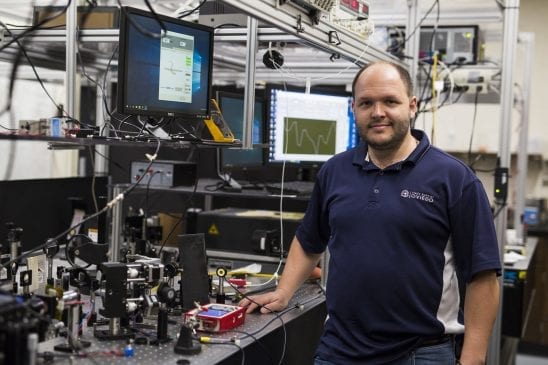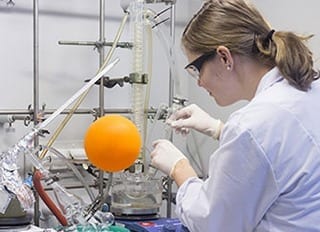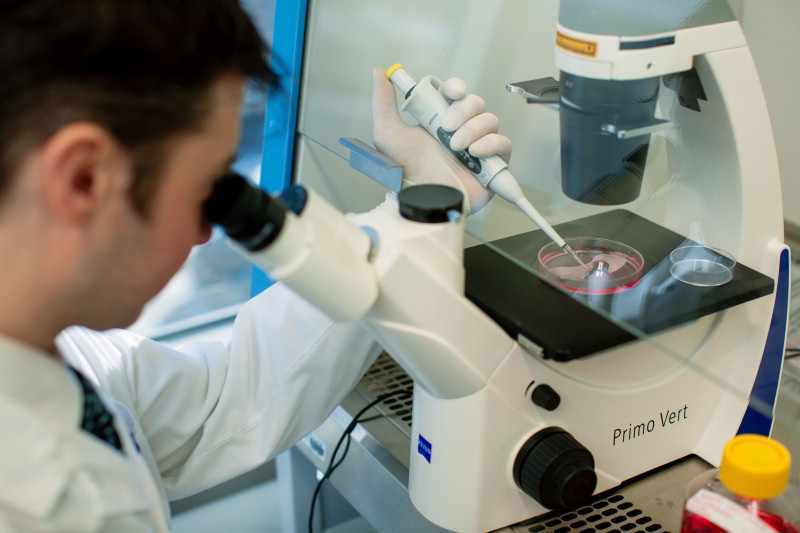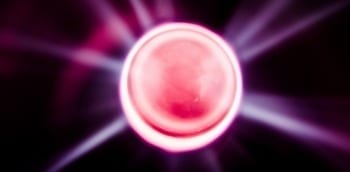
A UCF researcher has combined cutting-edge nanoscience with a magnetic phenomenon discovered more than 170 years ago to create a method for speedy medical tests.
The discovery, if commercialized, could lead to faster test results for HIV, Lyme disease, syphilis, rotavirus and other infectious conditions.
“I see no reason why a variation of this technique couldn’t be in every hospital throughout the world,” said Shawn Putnam, an assistant professor in the University of Central Florida’s College of Engineering & Computer Science.
At the core of the research recently published in the academic journal Smallare nanoparticles – tiny particles that are one-billionth of a meter. Putnam’s team coated nanoparticles with the antibody to BSA, or bovine serum albumin, which is commonly used as the basis of a variety of diagnostic tests.
By mixing the nanoparticles in a test solution – such as one used for a blood test – the BSA proteins preferentially bind with the antibodies that coat the nanoparticles, like a lock and key.
That reaction was already well known. But Putnam’s team came up with a novel way of measuring the quantity of proteins present. He used nanoparticles with an iron core and applied a magnetic field to the solution, causing the particles to align in a particular formation. As proteins bind to the antibody-coated particles, the rotation of the particles becomes sluggish, which is easy to detect with laser optics.
The interaction of a magnetic field and light is known as Faraday rotation, a principle discovered by scientist Michael Faraday in 1845. Putnam adapted it for biological use.
“It’s an old theory, but no one has actually applied this aspect of it,” he said.
Other antigens and their unique antibodies could be substituted for the BSA protein used in the research, allowing medical tests for a wide array of infectious diseases.
The proof of concept shows the method could be used to produce biochemical immunology test results in as little as 15 minutes, compared to several hours for ELISA, or enzyme-linked immunosorbent assay, which is currently a standard approach for biomolecule detection.
Learn more: New, Old Science Combine to Make Faster Medical Test
[osd_subscribe categories=’biochemical-immunology-test’ placeholder=’Email Address’ button_text=’Subscribe Now for any new posts on the topic “BIOCHEMICAL IMMUNOLOGY TEST”‘]
Receive an email update when we add a new BIOCHEMICAL IMMUNOLOGY TEST article.
The Latest on: Biochemical immunology test
[google_news title=”” keyword=”biochemical immunology test” num_posts=”10″ blurb_length=”0″ show_thumb=”left”]
via Google News
The Latest on: Biochemical immunology test
- Bio-Rad launches three StarBright Red Dyes and expands range of antibody markers conjugated to StarBright Violet Dyes to enhance immunology researchon May 1, 2024 at 9:19 am
StarBright Dyes are compatible with most experimental protocols and flow cytometers, including the Bio-Rad ZE5 Cell Analyzer, without the need for special buffers. Minimal lot-to-lot variation helps ...
- Urine Test Detects High-Grade Prostate Canceron April 18, 2024 at 5:00 pm
Researchers at the University of Michigan Health Rogel Cancer Center have developed a new urine-based test that addresses a major problem in prostate cancer: how to separate the slow growing form of ...
- BMSC.3310 Clinical Immunology (Formerly 36.331 and MLSC.3310)on April 6, 2024 at 10:32 pm
This course introduces the fundamental concepts of human immunology, focusing on the molecules ... are initiated and executed upon recognition of these entities, and the biochemical and physiological ...
- A Primer on Genetic Testingon March 10, 2022 at 12:58 pm
The lines are beginning to blur between the types of genetic tests as new applications of genetics technology are designed. Molecular cytogenetics is a type of genetic test in which molecular ...
- Medical Biochemical Genetics Admissions and Benefitson December 19, 2021 at 1:44 am
Currently, Medical Biochemical Genetics does not use the NRMP for those applying for the fellowship. Most individuals apply to the program 12-18 months before the anticipated start date. Interviews ...
- Monoallelic Expressionon December 7, 2021 at 10:41 am
Examining instances of monoallelic expression and finding connections to the genetic and biochemical bases for these disorders is one of many challenges facing scientists in the years to come.
- Gene Expressionon November 22, 2021 at 3:54 am
At any given time, the amount of a particular protein in a cell reflects the balance between that protein's synthetic and degradative biochemical pathways. On the synthetic side of this balance ...
- Lab 19 New Biochemical Testson April 30, 2021 at 11:12 am
1. Collect your inoculating loop, as well as your Gram-positive Unknown A and Gram-negative Unknown B, and proceed to the KOH test station. A solution of 3% KOH should be provided there. 2. Place a ...
- Allergy and Immunologyon December 18, 2020 at 3:47 am
We take detailed patient’s history and symptoms, perform a physical examination, perform and analyze the results from the allergy skin testing and other laboratory tests to determine what is causing ...
via Bing News










